As vacations go, Croatia doesn’t take much convincing. One glance at any Croatia-related hashtag on Instagram and you’ll encounter an array of spellbinding images, mostly depicting the country’s dazzling coastline with its clear-blue waters, fairytale seaside towns, and glamourous islands.
While no visit to Croatia is complete without time along the Dalmatian coast, this country is full of many other compelling destinations, so if you can spend at least two weeks, I encourage you to go further afield and experience all that this amazing country has to offer.
Following is the itinerary my husband and I planned for our two weeks in Croatia. While there are a few spots where I wish we could have lingered, overall this itinerary gave us a good sample of the country’s different regions. We’ve still only scratched the surface of Croatia, but this was a great start.
Overview of our itinerary:
To do this itinerary, or something like it, I recommend renting a car. (And as someone who works in the public transportation industry and loves taking trains and buses, I do not say that lightly.) The rail network in Croatia is not extensive, especially along the coast. If you can’t rent a car, traveling by bus is your best option.
Having a car gives you freedom and flexibility to explore Croatia’s back roads and conveniently get from place to place. The highway infrastructure here is also world-class, which makes it extremely easy to drive. When you contemplate the fact that only about 30 years ago this region was in the throes of war, it’s really quite amazing, especially when you then think about the relatively decrepit state of roads and bridges in the United States.
A few travel tips . . .
Before I jump into the detailed itinerary, here are a few quick planning tips:
- To be more efficient with your time, fly into one city in the north (e.g. Zagreb) and fly out of another city in the south (e.g. Dubrovnik), or vice versa. We did the north to south direction mainly because I wanted to end the trip relaxing on the coast, but it’s up to you.
- Go to Croatia during the shoulder season – May/early June or late September/October to avoid the throngs of summer tourists. If being there to enjoy the beaches and the sea is important, September is perfect though still a little crowded; that’s when we went.
- Rent a car to see more of the country, especially outside the major cities and towns.
- Bring water shoes or buy a pair once you arrive – the beaches are rocky!
Day 1-3 Zagreb
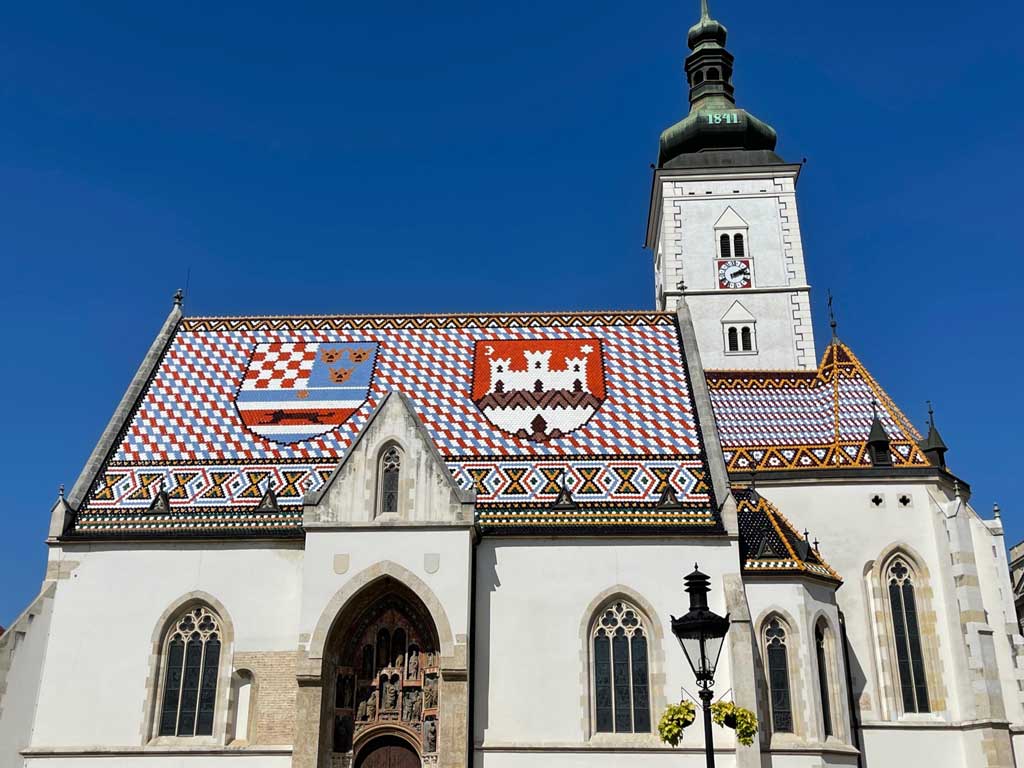
Not only Croatia’s capital but also its largest city, Zagreb is more akin to Central Europe than Southern Europe. For starters, it’s inland and also in the Northern part of the country, so it has more of a Prague or Munich feel than Mediterranean, which is what you’ll get along the Dalmatian coast. If you want variety on your Croatia adventure, adding Zagreb to your itinerary will do the trick nicely.
Zagreb is divided into three areas:
1. The thousand-year old Gornji grad (Upper Town), which contains the Presidential Palace, St. Mark’s Church with its iconic tiled roof, the Croatian parliament (Sabor), and the city’s many wonderful museums and galleries that line cobbled streets lit by gas lamps,
2. the 19th century Donji grad (Lower Town), where you’ll find vibrant neighborhoods filed with shops, restaurants, cafes, theaters, and parks,
3. the modern but drab Novi Zagreb (“new Zagreb”), which is full of high-rise buildings and not particularly interesting.
What I love most about Zagreb is that it feels so livable. Yes, tourists come here to visit, but unlike some of Europe’s more celebrated cities, tourism is not at the forefront, and you certainly don’t see as many American visitors as you will in Dubrovnik.
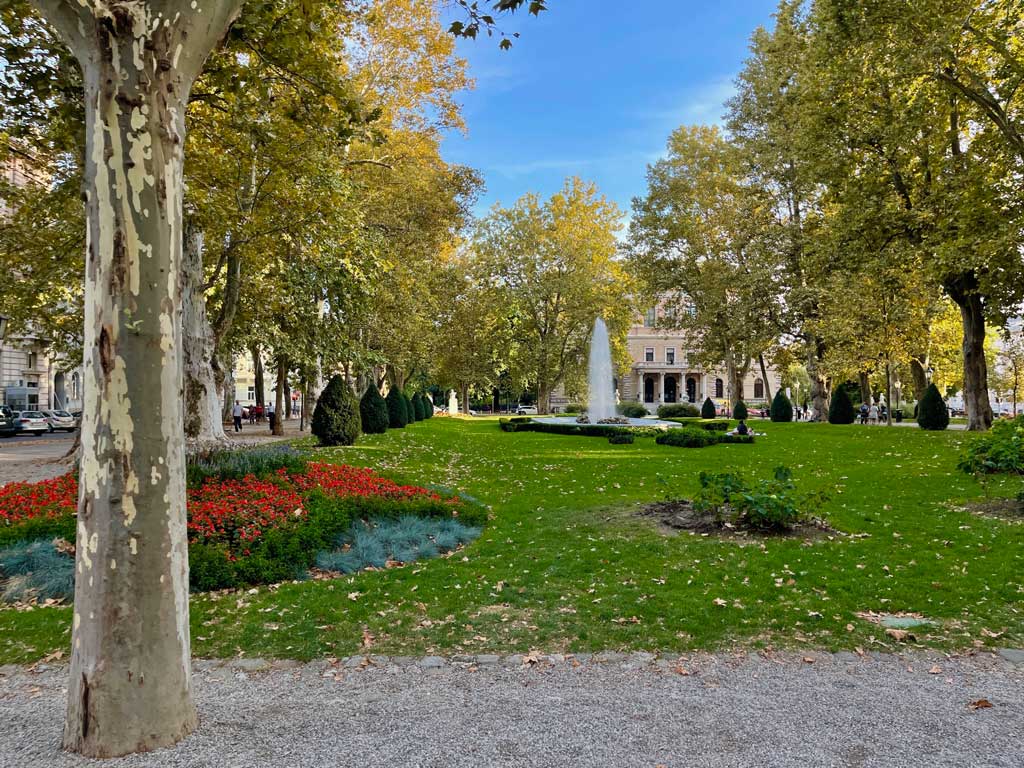
Zagreb is the perfect city for flaneurs, or “walking enthusiasts.” As you’re out and about, there’s a freedom from a long tourist “to-do” list you don’t always have in places like Florence or Rome.
With an abundance of green space, farmers’ markets, and nearby outdoor activities, Zagreb is the kind of place you could sink into for a while, enjoying a relatively laid-back, low-cost life.
Don’t Miss
Zagreb has some interesting small museums. In the Upper Town, in a lovely baroque building, you’ll find the comically depressing Museum of Broken Relationships with its relics and mementos of loves lost.
And just a block or so away, the Croatian Museum of Naive Art features more than 1,900 paintings, sculptures, and other work by self-taught artists, mostly from Croatia.
Where We Stayed
While I am generally drawn more to local boutique hotels or guest houses in Europe, we’ve been mixing Marriott family properties more and more into our travels, in part because we are Bonvoy members and often get good rates, especially in less “popular” cities.
In Zagreb we stayed at the Sheraton Zagreb Hotel, which turned out to be a great find. A little off the city center in a leafy, residential area, it was perfect – far enough from the action to be quiet, but close enough that we could easily walk to the main city sites.
It was also near the rental car place where we’d need to go for the next leg of our journey, as well as a funky beer garden where we met up with my brother visiting from Munich. (Leave it to the guy from Bavaria to discover the beer garden!)
Day 3-5 Rovinj
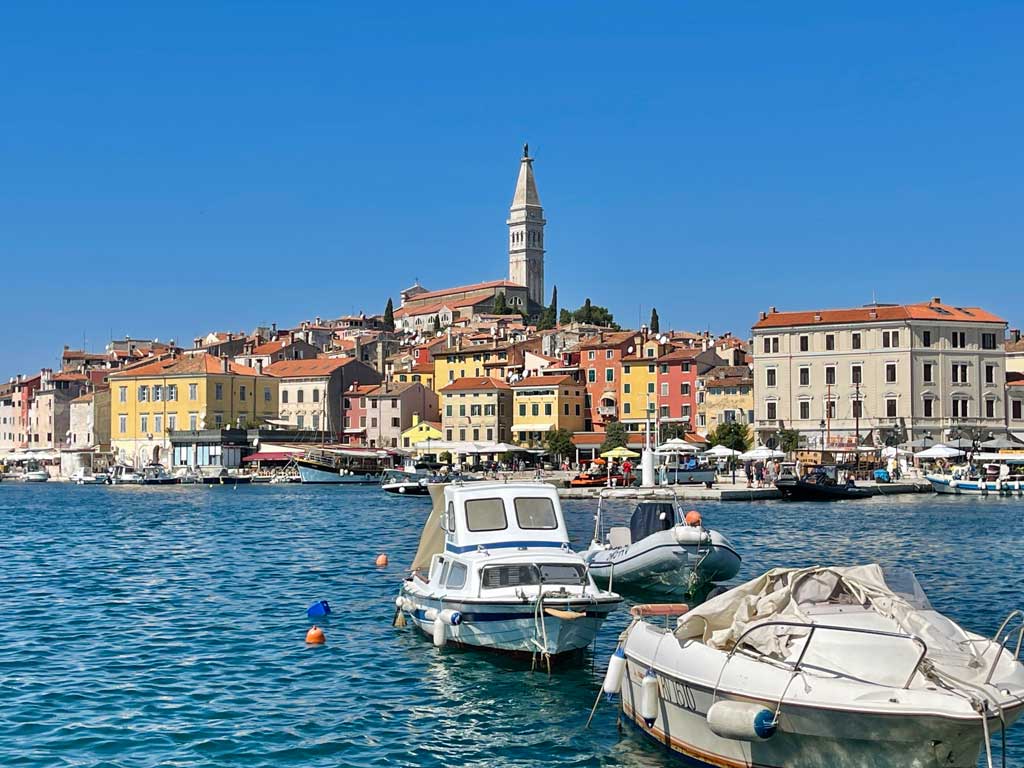
Even with our trip now in the rear view mirror, I dream of Rovinj daily and live there vicariously on Instagram. Located on the Istrian Peninsula in the northern part of Croatia – almost directly across the Adriatic Sea from Venice – Rovinj is often overlooked by American tourists who usually stick to the Dalmatian coast.
This is a shame. Rovinj, and the entire Istrian Peninsula, is lovely. It feels a lot like being in an Italian hill town on the water – not just because there are so many Italian tourists, but it (like much of Croatia), was once part of the mighty Venetian Empire and is only an hour from the Italian border.
It didn’t take long to discover the magic of Rovinj. On our first night, immediately after getting situated in our charming apartment in the center of town, we went out to explore, meandering to the water’s edge where restaurants and bars are positioned for prime sunset viewing.
At the lively La Puntulina, all the tables were booked, so we made ourselves comfortable on a cushioned spot along the rocky outcrop, enjoying a glass of wine and cheese plate while the sun melted into the sea.
Besides sunset, the best time to enjoy Rovinj is early morning when the polished cobblestone streets are near empty and the local fishermen quietly glide into the marina with the day’s catch.
Before the crowds (and the more intense heat), head to the Church of Saint Euphemia and climb to the top of the bell tower. As someone who is afraid of heights, I will say it is not for the faint of heart, but the spectacular view is well worth it.
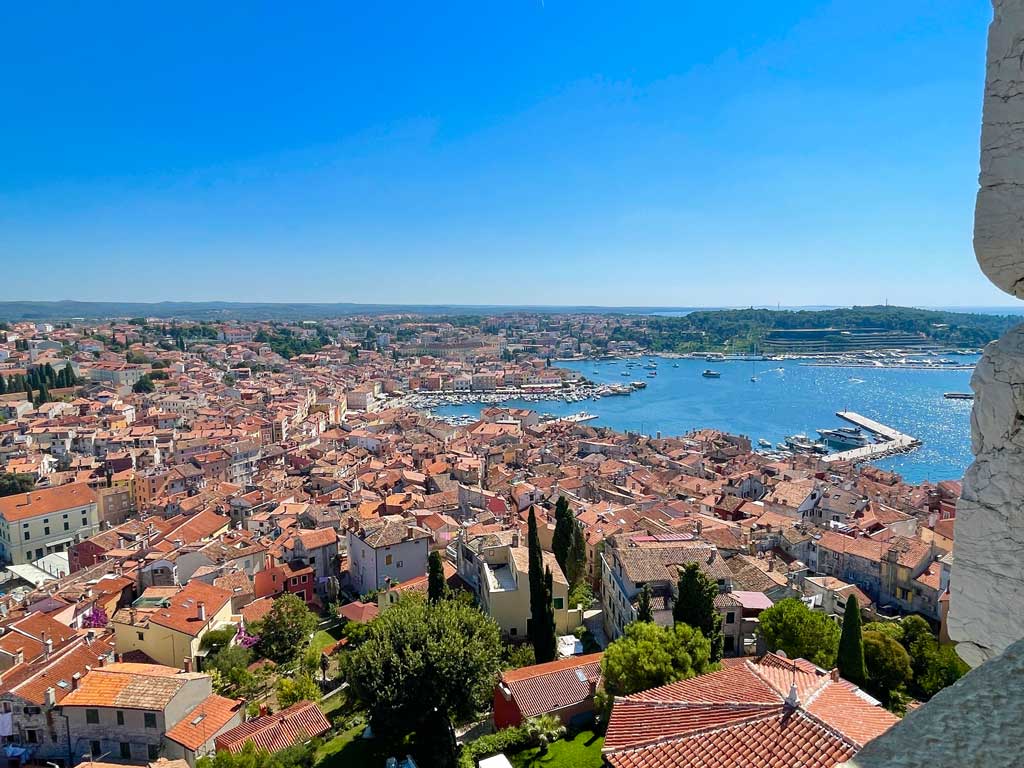
Midday can get quite hot. It’s the perfect time to head to the water, though be aware there are no sandy beaches for sunbathing. We found a flat area on the rocks to lay out our towels for a swim and slipped on the water shoes we had picked up in town. We noticed a lot of people also had padded mats to cushion themselves on the rocks. If you plan to spend a lot of time sunbathing in Croatia, you can always buy a mat locally and gift it to other travelers when you leave.
To cap off what had thus far been a perfect day, we enjoyed a dinner of mussels, gilthead, and truffle pasta, followed by street music in the main square that connects the historic Old Town and Rovinj’s newer neighborhoods.
Don’t Miss
If you have a car, I highly recommend visiting the ancient ruins of the medieval town of Dvigrad, which is about half an hour away and takes you through beautiful countryside.
Popular with road cyclists, the Istrian Peninsula is known for its vineyards and olive groves, so be sure to stop for a tasting or two. We also made a detour to explore the village of Sveti Lovrec, which was almost completely devoid of people.
Where to Stay
Inside Rovinj’s pedestrian-only historic center, there are any number of charming B&Bs and apartments to rent. We loved our place, CasaProva, because we could just pop out the door to explore the narrow alleys of the town’s historic core and walk to the many nearby restaurants and cafes. (Our apartment did have a very steep stairway, so it is probably not a good option for anyone with mobility challenges.)
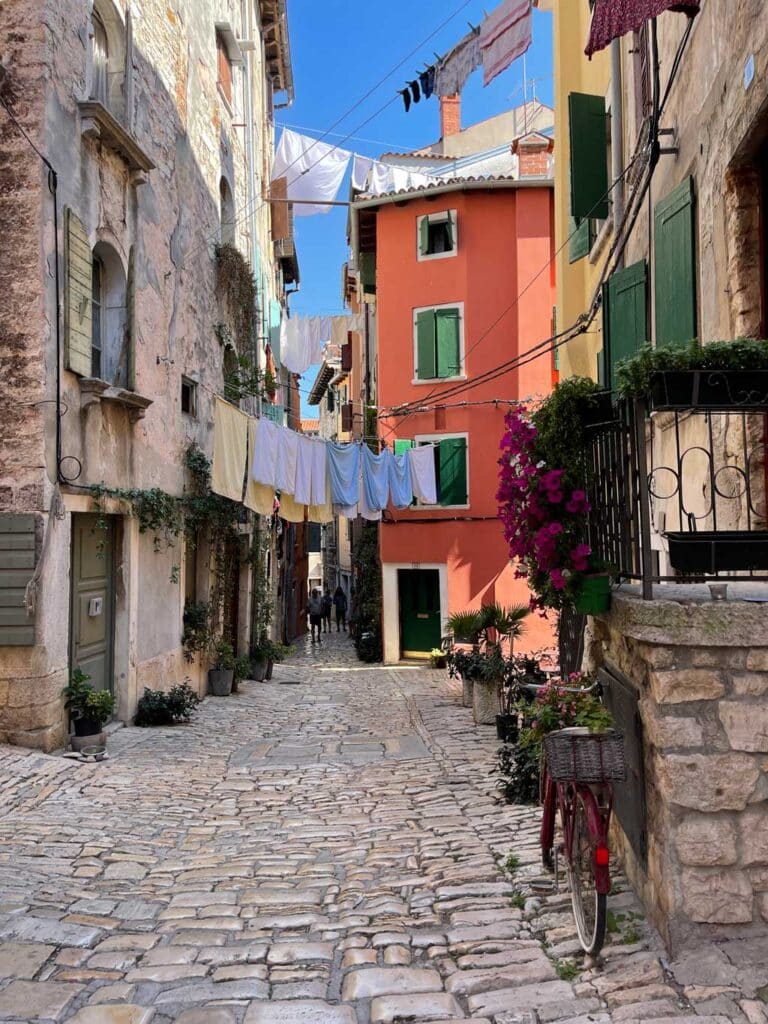
Be forewarned that the cobblestone streets and steep hills of Rovinj are tricky to navigate with luggage, and the higher up you are on the hill, the harder it is. Because no cars are allowed in the old town, we parked in a residential neighborhood about a mile away and it was a good walk to get to our place. Keep in mind too that if you stay in the town’s historic center, it can be loud depending on the location of your room.
If you prefer a quieter (and more spacious) spot, the residential areas where we parked seemed to have plenty of apartment and house rentals, and we saw lots of families with young children. It’s all a matter of preference.
Day 6-7 Plitvice National Park
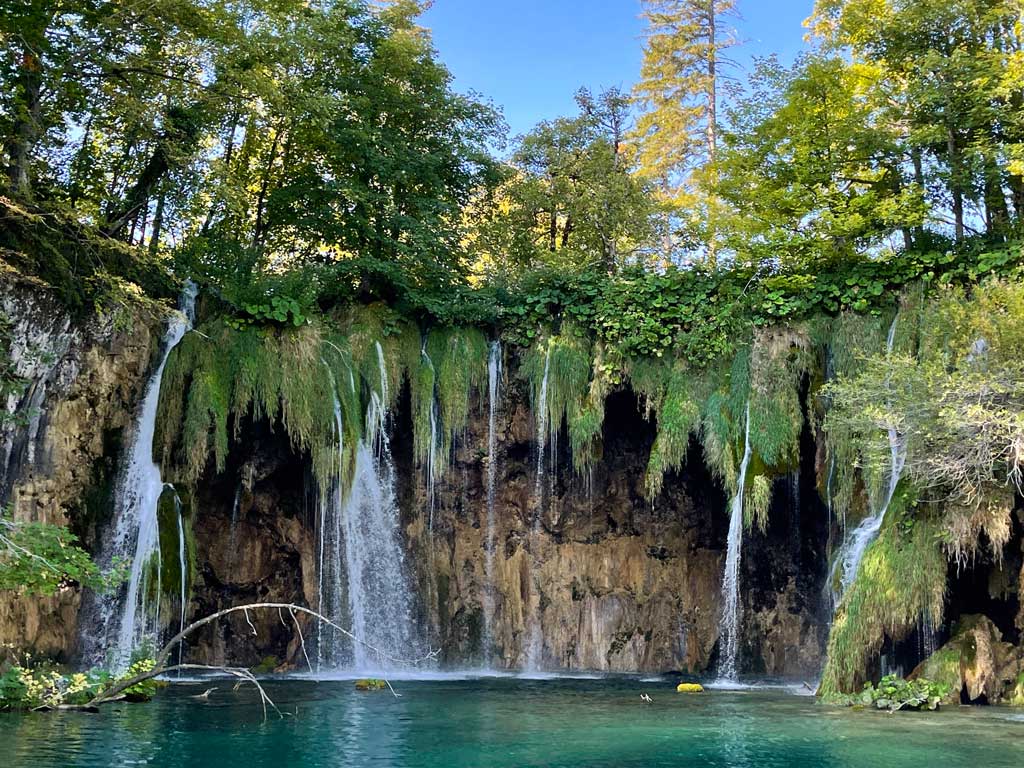
What to say about Plitvice? Wildly popular, Croatia’s largest national park is the country’s second most popular destination behind Dubrovnik. And for good reason; it’s nothing short of spectacular.
Plitvice covers 100 square miles with countless magical waterfalls that spill into 16 brilliant, aquamarine lakes divided into two sections – four Lower Lakes and 12 Upper Lakes. Eight mix-and-match routes along with a shuttle bus and two boat crossings make it easy for visitors to navigate the entirety of its enchanting landscape.
As wonderful as Plitvice is – and really because of how wonderful it is – your experience at the park will depend on how well you plan your visit. I’ve already written an in-depth guide to Plitvice here, but the gist of it is, if you cannot go during the less-crowded shoulder or off-seasons, you must get there in the morning as soon as it opens to avoid the late-morning/afternoon crush of visitors, usually with big tour groups.
I also recommend spending at least one night so it’s easier to arrive early (or stay later in the afternoon, which is less crowded too). An overnight stay allows you to spread out your visit over two days so you’re not rushing (with everyone else) to take it all in. Plitvice isn’t Yosemite or Yellowstone big, but there is still a lot of ground to cover.
Don’t Miss
For a spectacular birds-eye view and far fewer people, hike to the upper cliffs on the western edge of the park. You’ll find a narrow trail in the woods with three viewpoints overlooking the lakes and waterfalls. When you’re done, you follow a stone stairway back down through the Lower Lakes to the entrance. Take your time descending; it offers an unparalleled, almost crowd-free view of the park’s famous Veliki Slap, or Great Waterfall. Read more detail about this in my Plitvice guide.
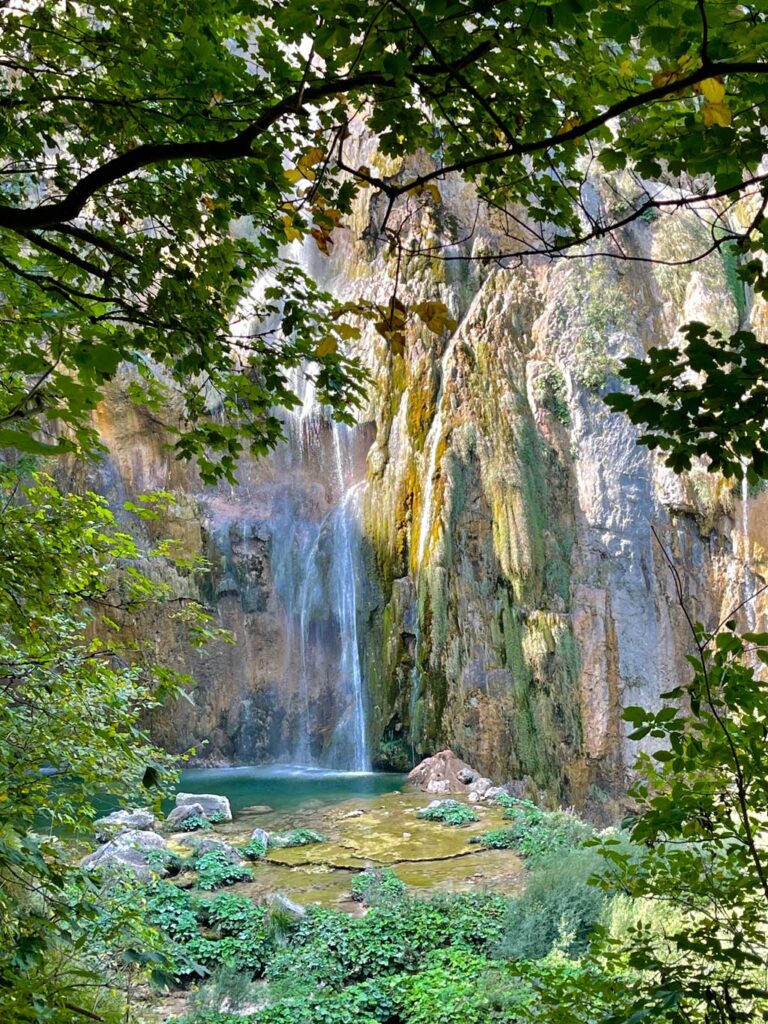
Where to Stay
Assuming you decide to stay more than a day, you’ll have a number of options. Within the park, there are three hotels: Hotel Jezero, Hotel Plitvice, and Hotel Bellevue, as well as two campsites: Borje Camp and Korana Camp. The hotels are relatively basic, but the advantage is you will be super close to the entrance, and you won’t have to pay a separate parking fee. If you’re taking a bus to the park, this is a great option, as you’ll get dropped off close to your hotel. Also, if you stay at one of these hotels, you can buy a one-day ticket and visit the park for two days as long as the hotel validates your ticket.
We chose to stay a little outside the park, as there are more options, and you get better value for your money. Many families in the surrounding villages rent rooms or apartments to tourists. We loved our stay at House Biba & Leona, located in the village of Rastovaca less than a mile from the park’s Entrance 1, which you can read about in my Plitvice guide.
Our spacious room was on the upper level of a home owned by a couple with two children and a sweet dog and cat. It was fascinating to hear their stories about how Plitvice was the site of some of the first shots fired during the Balkan War in the early nineties. In fact, the fighting between the local Croats and the rebel Serbs resulted in the park being seized and held by the Serbs for several years.
Day 7-8 Split
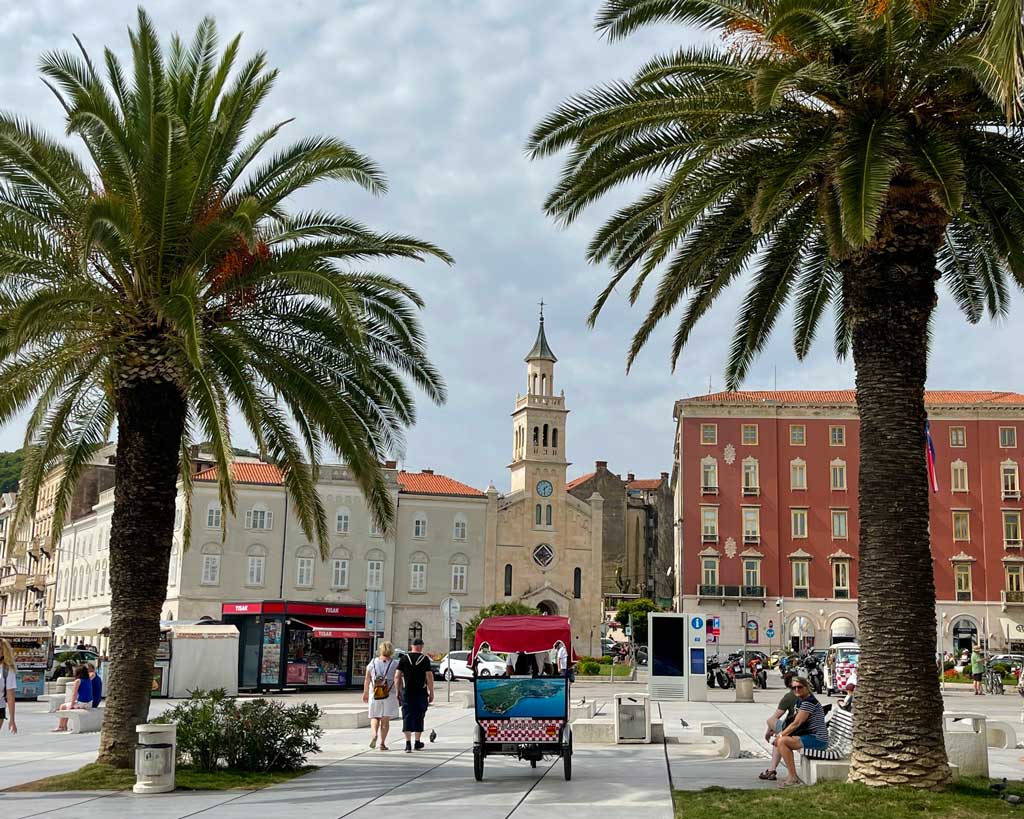
I’m not going to spend too much time on Split, Croatia’s second largest city, because we were only there a night and that was because our ferry to the island of Hvar (more on that in the next section) left from here.
Many of our friends who had been to Croatia didn’t love Split, so my expectations were not as high as some other places on our itinerary. That said, my less than 24 hours there left me wanting more.
Like Zagreb, Split is a big city that seems like a cool place to live if you get off the beaten path. The old part of the city gets inundated with tourists during high season.
Split absolutely brims with history that comes to life in Diocletian’s Palace, which today is the only “living” UNESCO World Heritage monument, meaning it is the only monument in which people actually reside. The “palace” was built in the 4th century under the direction of the Roman Emperor, Diocletian, as a retirement home.
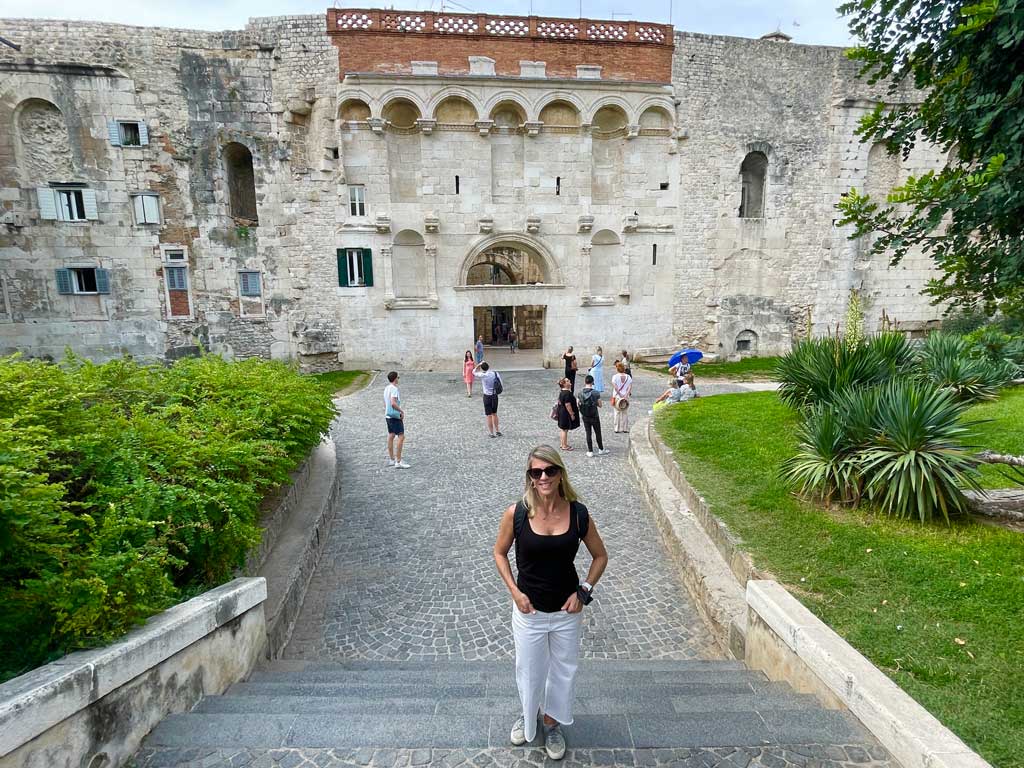
It’s less of a palace in the common sense of the word and more of a huge urban neighborhood confined by four walls and four entrance gates. After Diocletian’s death, people from the nearby city of Salona, which no longer exists, took residence within the palace walls (modern-day squatters?). Over the century, the city evolved into its current state, which is a fascinating mashup of Roman, medieval, Christian, and Venetian architecture and art.
Long story short on Split, it’s a neat place, and if you have time to go, spend a night or two – check out Diocletian’s Palace, ideally with a guide, and then explore other parts of the city like People’s Square with its numerous cafes, bars, and restaurants, as well as the Riva, which is the city’s beautiful, palm tree-lined waterfront promenade.
Day 8-11 Hvar

From Split, we boarded a car-ferry to the island of Hvar. Considered to be the one of the glitzier and more lively of the Dalmatian coast islands, the harbor is abuzz with an armada of double and triple-decker yachts like you’d see on the French Riviera.
Truth be told, you have a lot of options when it comes to Croatia’s islands – there are many, all worthy of a visit in their own right. I researched and agonized where to go way more than I should have. At the end of the day, I don’t think you can go wrong wherever you choose. Unless you’re lucky enough to be hanging out in Croatia for several weeks, I recommend picking one island and staying there rather than hopping around. In my opinion there’s not enough of a difference between them to warrant multiple stops, and it’s much more relaxing to stay in one place.
We stayed three nights on Hvar and enjoyed every minute. After lots of go, go, go in Plitvice and Split, we were ready to chill out at one of the island’s many beach clubs. Don’t be intimidated by their façade of exclusivity; clubs are open to anyone (though I’m sure there are private ones!), and they are more affordable than you’d think. We rented two beach chairs and an umbrella for $35 all day. With the warm, clear sea just steps in front of us, and a beach bar just steps behind us, what more could we ask for?
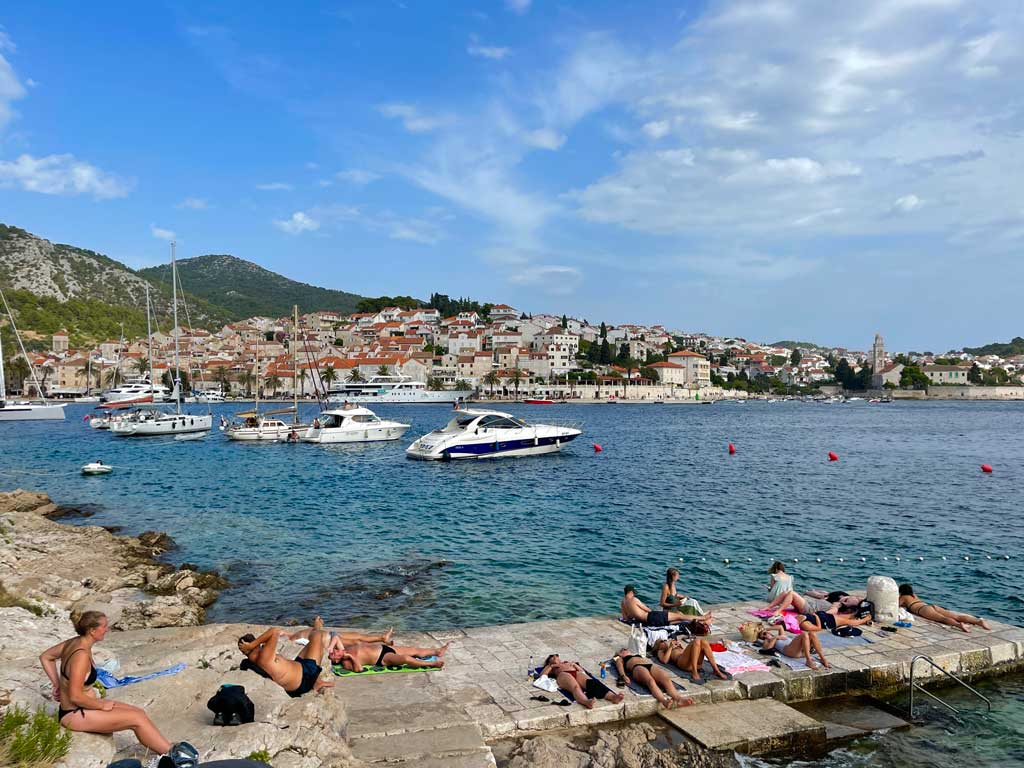
The food in Hvar is amazing, and there are a number of exceptional restaurants, including Giaxa, where we met a lovely couple from England; Konoba Bunar, which was right below our apartment; and Konoda Livija, which is a wonderful rooftop restaurant with a view of the fortress overlooking Hvar Town. (NOTE: You’ll see the word Konoba a lot in the Dalmatian region of Croatia. Usually translated as tavern or cellar, it generally refers to a “registered” restaurant where the dishes of the coastal region are prepared.)
Hvar is well-known for its night life, and you absolutely need to enjoy at least one evening at the lively Hula Hula Bar. Popular for sunset cocktails, it’s quite the scene with throngs of young people kicking off a night of festivities.
Even though Hvar is considered to be a party island, we found it easy to escape all the commotion – whether it be relaxing by the water or exploring the island’s wine vineyards.
One of the more popular side trips from Hvar (and from other coastal places too) is the Blue Grotto. You’ll see vendors lined up on the waterfront touting Blue and Green Island excursions by motorboat. Don’t be deterred by the cheesy, touristy feel because the trip is well worth it, and unless you have a friend with a yacht, it makes for a nice day out on the water of the Dalmatian coast. You’ll have plenty of tour outfits from which to choose; just be sure to find out exactly what’s included in the price and how many people will be on the tour with you. During high season tours can get crowded.
Where We Stayed
Our apartment in Hvar, Heritage Suites Zanini, was my favorite accommodation of the trip. I actually said to my husband at one point that I could see myself living there for a while. It had a small kitchen area (that we never used), separate living space, a little alcove with a desk, and lovely views of the neighbor’s pomegranate trees and garden.
Located a few walkable blocks off the main square, we loved that it had easy access to everything but was far enough to be relatively quiet. The Konoba Bunar restaurant just below is one of the best on the island and fortunately closed early enough not to disrupt our sleep!
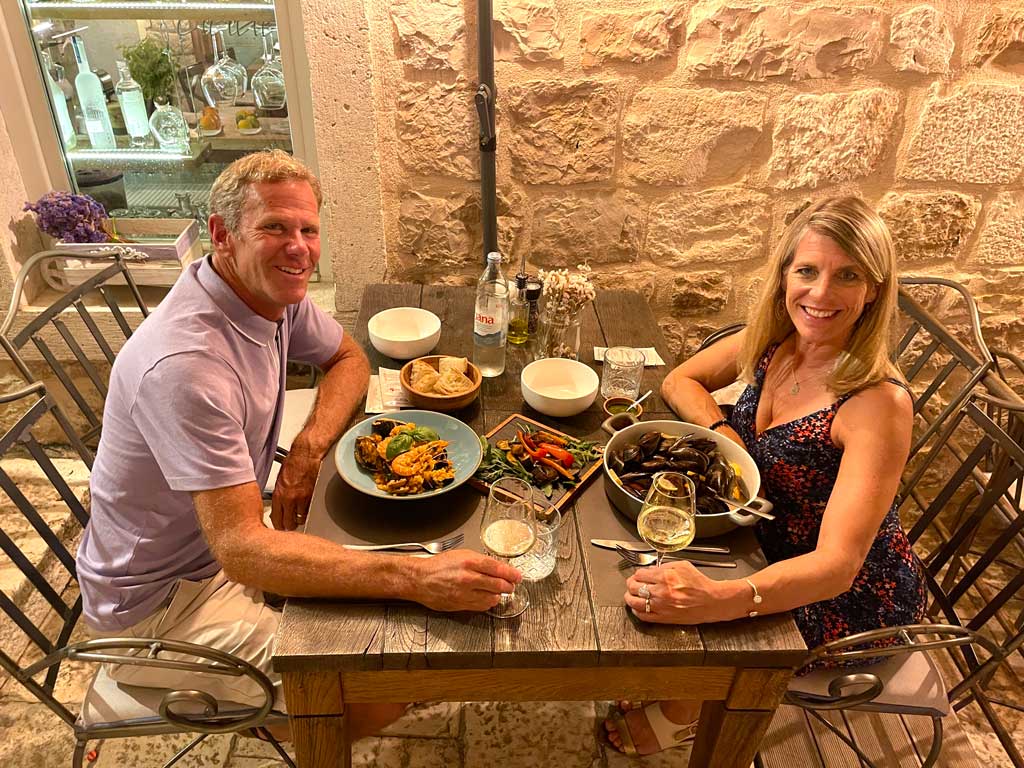
Don’t Miss
As you’re walking around, you can’t miss the imposing fortress, ‘Fortica Spanjola’, that presides over Hvar Town. Foreboding as it looks, you can climb to and go inside the fortress.
The roughly half-hour trek that takes you through the old town streets and onto a tree-lined hillside is fairly strenuous, especially when it’s hot. But the views are worth it. From the ancient fort, you’ll be able to survey the town, as well as the rest of Hvar and the surrounding islands.
There is a fee to enter the castle so don’t forget money, and you can grab a bite to eat at a café and snack bar.
Day 11-14 Dubrovnik
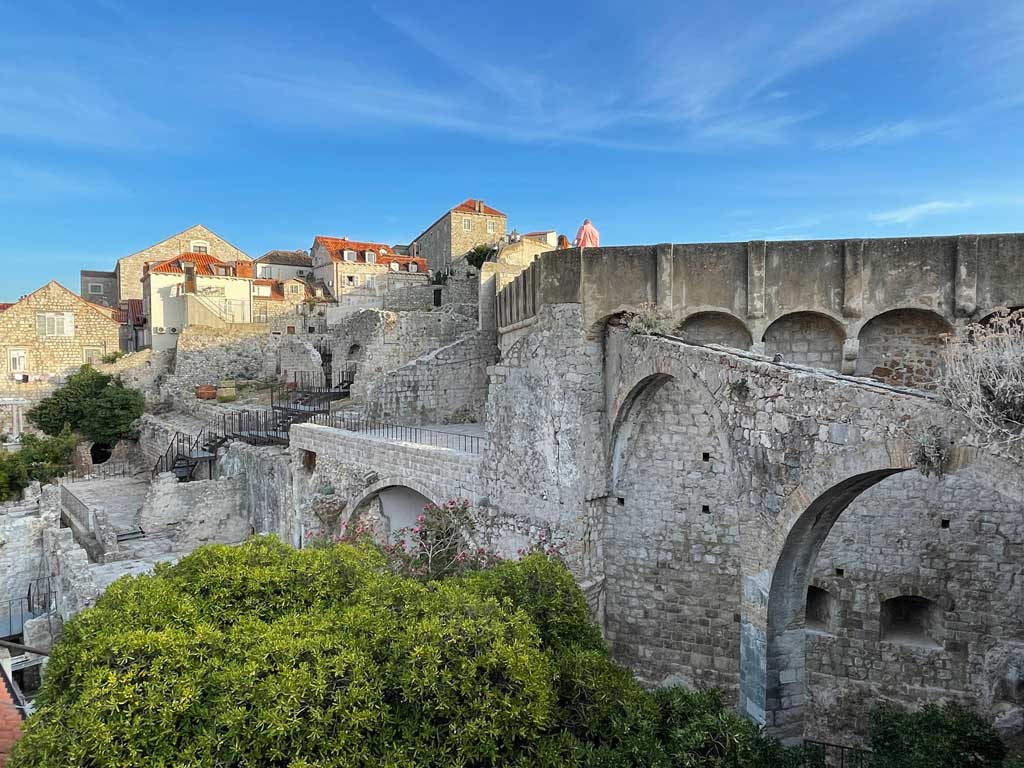
At long last we made it to Croatia’s crown jewel, Dubrovnik. For me, this had been a long time in coming. As a college exchange student in France many, many years ago (before the Balkan War, in fact), Dubrovnik had been on my list of places to visit. For a variety of reasons, I never made it, and I’ve been wanting to go ever since. So here I was, finally!
Our first glimpse of Dubrovnik was at night. Enchanting is an understatement. The limestone buildings are gorgeously lit, and despite being centuries old, they sparkle as if built yesterday. The polished stone walkways are equally magnificent, and in true European fashion, people were milling about enjoying the ambience of the bustling restaurants, shops, and plazas.
It probably goes without saying that Dubrovnik’s historical core within its famous medieval walls is a car-free zone, so whether you are staying over or visiting for the day, you’ll need to park outside, and it can be very frustrating. This website provides a good run-down on your options; we used the big underground garage on the hill above Dubrovnik because it was the most economical for longer-term parking and felt very safe. It’s a good 15-minute walk to Old Town and is steep on the return but overall a nice way to see the less-crowded neighborhoods where people live.
How to Avoid the Crowds in Dubrovnik
Because Dubrovnik is so popular, the challenge is figuring out how and when to see it without a million other people. Going in the shoulder season, as we did, is a smart move. It’s also a good idea, if you can, to avoid visiting on days when cruise ships are in, as the city is inundated with tourists from roughly late morning to early evening. You can use this website to determine when cruise ships are docked. Fortunately for us, we were there in September 2021, and most cruises were still on hold due to the pandemic.
My strategy for avoiding crowds anywhere I go is to get out and explore early in the morning before everyone is up, or in the evening when the big tour groups have left. Both of these times are also great for taking photos!
What to Do in Dubrovnik
We spent two nights and had roughly two days in Dubrovnik (not including an incredible day trip to Kotor, Montenegro), and we felt it was plenty of time.
Just walking around Dubrovnik to take in all its splendor is a joy. The first part of town you’ll likely encounter is the Stradun, which is Dubrovnik’s main pedestrian thoroughfare that stretches from the Pile Gate at the town’s western entrance to the Old Town’s port. Unsurprisingly, its line-up of restaurants, shops, and cafes attracts hordes of people.

To learn more about the city’s fascinating history and get the lay of the land, consider taking a walking tour – there are many options, so you shouldn’t have trouble finding one that suits you.
Game of Thrones fans even have tours that visit the show’s various filming locations. I’m not a GOT fan myself, but it was pretty cool to see the iconic Jesuit Staircase where Cersei Lannister began her “Walk of Shame.”
While the main streets and plazas are maddeningly packed during peak tourist season, it doesn’t take too many right and left turns away from those places to find yourself in quieter, near-empty alleyways. Don’t be afraid to get lost – it can result in the most memorable experiences.
Of course, if there’s one activity that cannot be missed in Dubrovnik, it is to walk the complete circuit of the City Walls. Originally built in the 13th century, the walls protected the city from the outside world, mainly the mighty Venetians. Requiring a ticket and entrance fee, the wall is 1.25 miles to walk. Along the way you’ll have amazing views over the terracotta rooftops out to the glittering Adriatic.
I highly recommend taking a guided tour of the city walls as it provides valuable historical context to your visit. We did one called “Ancient City Walls & Wars” with Dubrovnik Walks, which was outstanding. Our guide, Davor, brought the city to life, sharing his experience as a young boy during the Balkan War in addition to chronicling Dubrovnik’s long and fascinating history. You can read my review on Trip Advisor here.
Don’t Miss
A visit to Dubrovnik is not complete without sunset and a cocktail. One of the most memorable experiences we had was watching the sun set at a café on the wall before being shooed off. (The wall has opening and closing hours and requires a ticket – you can’t just walk on it whenever you want.)
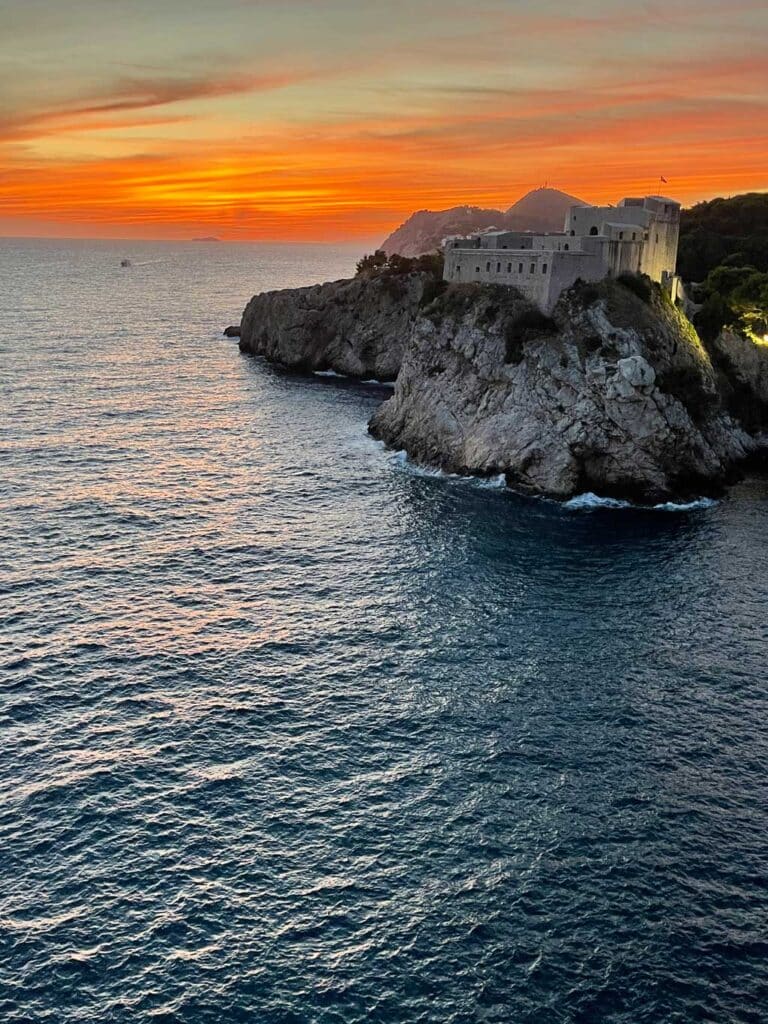
Our strategy for catching sunset on the wall was to book our tour mentioned above late in the afternoon and stay on the wall until it closed, which was right around sunset. We ended up being one of the last visitors to be escorted off, and it was so cool to have the walls almost to ourselves for a bit of time. (Note: Your wall entry ticket does not allow you to leave and then return later in the day, so plan your time wisely.)
Another popular spot for watching sunset in Dubrovnik is Buza Bar, which is literally a hole in the wall that takes you out to tables perched on cliffs. Good luck getting in though – it used to be a hidden gem but has become wildly popular. I should also note that depending on the time of year, your view of the sun actually setting may be obscured by the wall. Still the golden hour glow is wonderful.
Where We Stayed
For our three nights in Dubrovnik we stayed about 15 minutes outside the walled city, despite originally booking an apartment in the center of Old Town.
While there are definite advantages to being right in the middle of Dubrovnik’s hustle and bustle, we wanted a little more peace and quiet at the end of our trip and found it at the Sheraton Dubrovnik Riviera Hotel, located on Sbrebano Bay, with a nice beach and kayaks to rent.
The drive into Dubrovnik was admittedly a bit of a pain because we had to keep parking at the garage I mentioned above, and the road into town is high on a cliff, making the ride a little hairy.
That said, being outside of the walled city also gave us the opportunity to explore more of the picturesque coast around Dubrovnik. This part of Croatia is relatively high end (think Malibu or Carmel-by-the-Sea in California), and while Dubrovnik gets all the love, nearby towns like Cavtat, Mlini, and Orašac are as lovely and enjoyable as any place in Croatia.
The moral of the story is that it’s hard to go wrong no matter where you go in Croatia.
